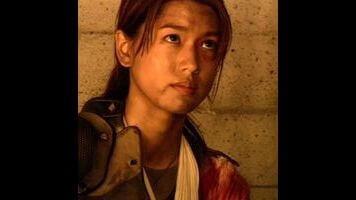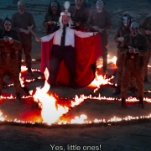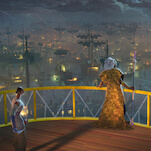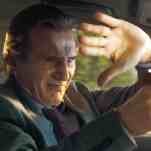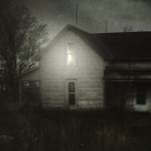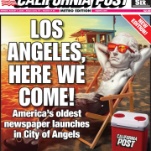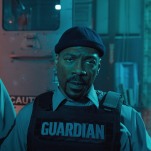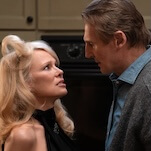“Kobol’s Last Gleaming” is a masterwork.
There is so much happening here that I am barely going to be able to do it justice, and that’s with 20-odd screenshots and copious notes. An episode like this almost renders further discussion of it meaningless, because it needs to be experienced, and felt, in order to be understood.
It means that there’s so many different possible avenues of interpreting the events of “Kobol’s Last Gleaming,” so many different levels of understanding them. It’s one of the things that came up with “33,” the episode that kicked off the regular television season for BSG: You can see “Kobol’s Last Gleaming” as an exercise in religious ritual—“All this has happened before, and all this will happen again”—or a character drama about human frailty, or a parable for our own experience of humanity, or something else I haven’t even thought of. But the best part is that you can see it for being all of those things, at the same time.
So it does seem a bit mundane, given all this, that the events of this season one finale are set in motion by two frakked-up people finally having sex. Throughout this season, Gaius and Kara Thrace have been positioned as opposites to each other, as I’ve explored a bit in earlier reviews. Where Gaius is the personification that everything that makes humans sort of despicable—the grasping, striving, Slytherin-ness of the world—Starbuck is brave, reckless, loyal, and brilliant. What they both have in common is poor impulse control, or maybe just a lot of libidinal energy—another pretty human thing, the unbridled desire to reproduce. (The Cylons we meet have sex with humans, but not with each other, apparently.) Whatever it is, the two have bad romance written all over them—haul in all the clichés about opposites attracting, or yins and yangs, or assured mutual self-destruction.
But the way the episode introduces us to these two frakking is devious—because it’s supposed to be Lee! The very last episode ended with the two of them dancing (though Gaius was also there, flirting); Lee and his father are sparring during the sex scene, indicating it could be about him; and yo, it actually is him, for the first few scenes.
There’s a lot of audacity there, baiting ’shippers that hard with the image of their OTP finally doing it (Ronald E. Moore must have been borrowing from Chris Carter’s playbook, damn that man). But besides just audacity, it’s the story entering the viewer’s headspace sort of sideways—a bait-and-switch, a made-you-look. And the vision is real enough, as far as things in Battlestar Galactica go, a universe where a man is in love with a robot woman he only sees in his head and scrolls from 3,600 years ago predicted the death of Laura Roslin.
Reality, when it dawns on Starbuck, Gaius, Lee, and the audience, is an unpleasant kick in the stomach.
This moment is the spark that lights a long fuse to a stockpile of dynamite—a fuse that ends up lighting the world on fire. A small act of betrayal—which is, in itself, an act of love, though directed to someone who isn’t there—sets into motion a branching chain of events that don’t even entirely make sense to us, the audience, even though we’re watching as it goes. Boy meets girl; girl loses to guy at octagonal card game; and a few episodes later, girl and boy are having sex in someone’s bunk, and girl cries out the wrong name at the moment of impact, as it were. Cut to: Girl gets on alien ship and hyperlight jumps to another planet to have a prolonged fight with boy’s corporeal girlfriend, while boy crash-lands onto a holy planet and has an intense religious experience that is explicitly staged and coded to look like a wedding.
There is something incomprehensible and fascinating about the chain of events locking into place, following this moment in time. It’s like a Rube-Goldberg machine inexorably moving forward, or an intricate pattern of dominoes cascading towards its ultimate goal. There is a sense of falling—of inevitability—but the pattern is opaque, even as you can see how each piece connects to the other. Only the watchmaker of the universe would really get why it has to fit together like this, and the watchmaker is typically not available for comment.
All this has happened before, and all this will happen again. To put it another way, time is a flat circle. To put it an entirely third way: We are all lost in labyrinths with many forking paths; sometimes they are mazes of our own making. And lest you think I am pulling this out of nowhere—looking down from above, Laura Roslin’s vision of the ruins of the City of the Gods is a flat circle, with branching paths leading away from it.
From Jorge Luis Borges’ “The Garden Of Forking Paths,” which was published the collection Labyrinths:
In all fictional works, each time a man is confronted with several alternatives, he chooses one and eliminates the others; in the fiction of Ts’ui Pên, he chooses— simultaneously—all of them. He creates, in this way, diverse futures, diverse times which themselves also proliferate and fork. Here, then, is the explanation of the novel’s contradictions. Fang, let us say, has a secret; a stranger calls at his door; Fang resolves to kill him. Naturally, there are several possible outcomes: Fang can kill the intruder, the intruder can kill Fang, they both can escape, they both can die, and so forth. In the work of Ts’ui Pên, all possible outcomes occur; each one is the point of departure for other forkings. Sometimes, the paths of this labyrinth converge: for example, you arrive at this house, but in one of the possible pasts you are my enemy, in another, my friend.
The story is about a Chinese man, working for the Germans in World War I, who discovers that he has a profound connection to someone at the same time that he realizes that he must murder that person. ”In one of the possible pasts you are my enemy, in another, my friend.”
In “Kobol’s Last Gleaming,” a racially Asian woman, working for the Cylons in the second Cylon war, discovers with dawning horror that she has to murder copies of herself in order to fulfill a crucial mission, while simulatenously discovering that she has to murder a man she looks up to so that she can fulfill another, more secret, crucial mission. And all this while discovering that she is a Cylon, and that her whole life’s mission is folding back on itself, to both create and destroy her, simultaneously.
In another story in Labyrinths, Borges offers this:
Thus, all inadvertence is deliberate, every casual encounter is an engagement made beforehand, every humiliation is an act of penitence, every failure a mysterious victory, every death a suicide.
I can’t think of anything better to explain the events of “Kobol’s Last Gleaming”—and of the particular journey of Eight, whose many copies commit some kind of self-sabotage in these two episodes—than the peculiar self-destructiveness of free will, as it infects Cylons and humans alike.
For “Kobol’s Last Gleaming” is the story of Boomer’s suicide, pursued through intricate, sideways means. Even if her death doesn’t happen on-screen, as with Lee and Kara’s lost sex scene, it’s conjured, outside of space and time, for us, the viewers. She attempts to kill herself, twice, and fails both times; her fellow copy Sharon is shot at by her lover, and spends the rest of the finale bleeding from her shoulder. And when Boomer is asked to run a suicide mission (because Starbuck, who was supposed to do it, went rogue), she meets and then blows up countless copies of herself, copies who claim that they are here for her, and love her, and always will. Boomer’s shooting of Commander Adama is arguably one of the most intense cliffhangers this show has pulled off, but by the time it happens, as viewers we’ve been primed to understand it, even if we’re not exactly expecting it.
And Boomer’s relationship with her own duality—her Cylonness and her humanness—comes out with numerous struggles between polarized forces in “Kobol’s Last Gleaming,” as units that were coherent start to split apart. Violently split apart. Lee and Kara—always an unstable pair—actually come to blows; Commander Adama and President Roslin are committing acts of war against each other; Head Six slams Baltar’s head into a mirror; and Helo shoots Sharon. Not that surprisingly, these are all dualities that are relationships between men and women, all of which have shades of romance underwriting them. The undercurrent in every one is of intimacy which has been twisted to violence instead of affection. Kara and Lee can’t figure out how to tell each other how they feel (or to just kiss, like normal human beings) so instead they sock each other in the face. Adama can’t get Roslin to see his point of view so he invades her ship and takes her prisoner. Helo’s so stung by his betrayal that he tries to gun down the woman he’s fallen in love with. Even Billy and Dee, the most lightweight couple on the show, are pulled apart by opposing forces, as their loyalty to their respective superiors holds firmer than their loyalty to each other.
The first episode of this season, the first shot of the miniseries, presents the invading force of the Cylons as a beautiful blonde woman in a red dress, positioning herself and her ilk against the entire human race. The intimacy of war is counterbalanced by the intimacy of sexuality. But to draw a distinction between the two is a false dichotomy, of sorts—all intimacy is ripe with potential for both love and destruction. “Kobol’s Last Gleaming” exposes the battlefield of attempting to reconcile your existence with the existence of others—whether those others are men, women, or Cylons.
One of the things this episode uncovers is that the Cylon plan, the one referenced in the opening titles in every episode, is about breaking down a duality to create some kind of harmonious third—baby makes three, quite literally. We’ve had an inkling that this is on Six’s mind, and it’s clearly been Sharon’s plan in taking up with Helo, right from the start.
And it’s a quest rooted in religion. Sharon says: “It was the next step. It brings us closer to God.” It’s a fascinating statement, because it’s not exactly obvious. How so? Is the act of bringing life into the world honoring God, who brought all lives into the world? Is bringing more souls to love in the world an extension of God’s love? Is it closer to God because procreation is one of God’s commandments?
Or is it purely that introducing a triad, instead of mere duality, introduces God into the pointless Us/Them conflict that is human existence? Triple deities are a constantly reoccurring phenomenon, across time and space. The Norse, Greek, and Hindu gods, which all share a lot of qualities with each other, are built in threes; Christianity introduced the “holy trinity” into our lexicon. And at least in the case of Christianity, that third, nebulous force, the holy spirit, was introduced into the notion of the divine specifically to undermine the duality between what made Jesus godly and what made him human.
The latter half of “Kobol’s Last Gleaming,” in particular, is one long religious allegory, carefully shot by Michael Rymer to create storytelling that is less about What Really Happened and more about What It Actually Means.
And most of that revolves around not Boomer, not Starbuck, but Gaius Baltar, who has been spared by God for a particular plan that he is still learning the particulars of. And if “Kobol’s Last Gleaming” is an examination of fate and of suicide and trinities, it’s also a close examination of the soul of Gaius Baltar, if such a thing even exists.
It comes back to that first moment, again, where Starbuck says the wrong name while having sex with the vice president of the Colonies. It’s awkward, yes. But Baltar’s feelings are actually hurt, and that’s one of the first surprising developments of “Kobol’s Last Gleaming”—because up until now, we haven’t really seen Baltar capable of emotional vulnerability. He’s mostly a combination of sycophancy and vanity and oozing self-interest. But he’s still human—and even his well-honed reflexes for self-preservation fail him, here, as he lets himself get his heart broken by Starbuck (who he damn well knew was never really going to care about him).
And in the fallout, Six grows increasingly angry with him, forcing him to deal with her, instead of drowning himself in drink as he wants to. The grasping nature of their relationship—a romance based on mutual need and rapacity more than it is on attraction and love—makes Head Six totally nuts; she said she wouldn’t get jealous, but here she is, jealous, and Baltar is feeling trapped. It’s played up for comedic effect, as it damn well should be, because James Callis is never more hilarious then when he’s acting the dissipate drunk or yelling at Laura Roslin and Head Six about two different things at the same time (the crowning moment being when they both respond in unison, “…plaything?”). And for a while there, Gaius’ relationship with Six is on the rocks.
And then he crash-lands on Kobol, and everything changes.
Six saves him from hell. From this moment on, we are off the grid with Gaius and Six, as they continue into a realm of storytelling that is on a totally different plane from everyone else in the show—one where every moment is laden with some kind of significance, because we have moved from the main storyline of things actually happening to the implied consummation, the possible events, the realm outside of time and space.
One big way director Michael Rymer pulls off this feeling is with literal looking up and looking down—emphasizing that first duality, between heaven and earth, and using Gaius and Six as stand-ins for it.
Another is creating, through symbol and form, a marriage between the two—a consecration of their union, in the eyes of God. They’re wearing the right colors for the modern-day Western wedding:
They clasp hands—a handfasting ritual of sorts:
They walk down an aisle together, to an uncertain future, in a tall, hallowed building filled with pews.
My notes for this image are “Adam and Eve in the Garden of Eden.”
And then, of course, there’s this:
A cradle all lit up with holy light, and the proud parents who aren’t really the parents, and it’s the consummation of a wedding, and is the third party in this marriage God, or the baby, or are they both the same? It’s literally up to you; this is a Rorshach test for your own interpretations. But there is an awful lot going on.
And while religious allegory of one sort is happening over on Kobol, another type entirely is happening on Caprica, where Starbuck is completing the last few steps in the wheel of the hero’s journey, the one she has been on all season. This is Starbuck returning to the Shire to find that things aren’t quite the same there; having crossed light years to perform her quest, she’s now setting out to reclaim or set aside “home,” whatever or wherever or whenever that is.
So essentially, the denouement of that storyline plays out like the meeting of a final boss in a video game. Right down to the magical macguffin!
And after the prolonged battle for the Thing Of Importance with her last lover’s current girlfriend (sort of)—which is a symbolically fraught battle in and of itself, though who knows what it means—the hero triumphs, and collapses in a heap of what looks a lot like the culmination of ecstasy.
The problem with the hero’s journey is that it’s never really over. Starbuck vanquishes one enemy only to find another. And Katee Sackhoff’s strangled cry of “She’s a Cylon!!” is one of the best line deliveries she’s done, followed by a complete devastation, and she realizes she needs to rebuild her world.
But in between the buildup and the denouement is that little space in the middle, where the story breathes for just a second. There are two scenes of significance on which the whole two-hour finale turns, and the essence of both is what I chose for today’s subheading: “I believe.”
There is no good reason for Roslin to have selected Starbuck for her mission, just as there is no good reason for Baltar to have dropped by to talk to Boomer at the exact moment she was thinking of killing herself. There’s certainly some explanation you could find, in the plot, but the fact is that these are conversations between two sets of characters who rarely ever have a chance to interact. And in both, what changes the course of history is belief: Laura’s own belief, and her ability to recognize that belief in Starbuck, who is a surprisingly pious pilot. And Baltar’s far more manipulative conversation with Boomer, in which he seems to be able to relay to her that he understands that she’s a Cylon, and he forgives her, whatever she chooses, because he believes in her.
You could pick apart those scenes however you’d like to find the truth of them; there are many layers. It seems like Baltar is offering Boomer a chance for confession—or last rites—or a death sentence. It seems like Laura Roslin is sending Starbuck on a suicide mission, while sending herself on one, too. It could be those things, or something else, too.
But what I think it means is how much what we believe about ourselves determines our path in the world; and more, how our many errors are in fact part of God’s design. What Baltar offers Boomer is the hope that she is okay, that she is worthy, that fulfilling her truest nature, her conflicting ideas, is part of the way the world should be. And what Roslin offers Starbuck is the opportunity to make a huge mistake—to go out in a blaze pursuing an artifact from a line in a scroll.
All of this has happened before, and all of this has happened again. And we are playing our parts in a story that happens again and again, in the cycle of time. Our frailty is part of the plan. And as Roslin observes herself, drily: “It is crazy, perhaps. But that doesn’t make it any less true.”
So say we all:
- Original airdates: 3/25/2005 and 4/1/2005
- Survivor count: 47,897 and 47,887
- Six theme count: 3
- Adama monologue count: 1. “You gotta lose control. Let your instincts take over. That’s why you don’t win.”
- “Would you miss me, sir?” A thousand Lee/Kara ’shippers cried out, and were silenced.
- A lot of amazing moments from Tricia Helfer in these two episodes, but her presence during the Baltar/Boomer confession is arresting. “The model is weak. It always has been.” And then as Gaius keeps talking, she has bright, unshed tears in her eyes.
- “Bringing home the cat, sir.”
- “No one coerces Starbuck. Believe me, I’ve tried. … If she can turn Starbuck against is, she’s capable of anything.”
- The music in these two episodes…. I just can’t. It’s perfect.
- It made me laugh, how many people cursed Lt. Gaeda under their breath in this episode.
- “I’m home! Wow, I’m home.”
- I just had to screencap Baltar being a drunk asshole, because it’s actually so brilliantly played:
- Office of the XO: As many of you know already, I’m leaving The A.V. Club, and this review is actually my last one for the site. Unfortunately, that means that Battlestar Galactica’s classic reviews are going to be put on hold. The saddest part about leaving is that I won’t be able to finish out the series with you guys. But now that the first season is done, it’s very possible that another writer will step in finish the second and third season. It’s been a privilege to re-experience the first season with you all. And I am honored to be able to go out on such a high note.
- And now it’s your turn: What’s your highlight of season one? The best moment, or sequence, or subplot? Lee and Starbuck punching each other in the hangar bay is wonderful, but I think the moment that always stays with me is the one where Starbuck learns how to fly the Cylon raider. I imagine she felt a little like I do now, stepping from the world that is known to a world unknown, terrified and elated, too.
- What do you hear, readers? Nothing but the rain.
